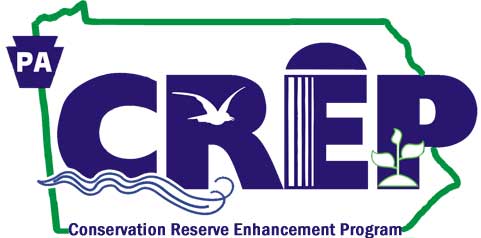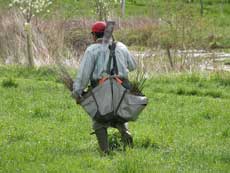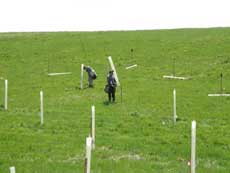Re-Enrollment of Expiring CREPThresholds for determining re-enrollment eligibility of acres under contracts
CP1, Establishment of Permanent Introduced Grasses and Legumes 60% of introduced/planted perennial grasses and/or native perennial grasses must be present on the entire enrollment practice acres to be considered eligible for a new contract. The remaining 40% can be other species that are beneficial to wildlife. Reed canary and common reed can be part of the 40%, but not part of the 60%. Encroachment of tall fescue cannot exceed 10% of the cover. Woody vegetation encroachment into a grass practice is a non-compliance issue because the cover was not properly maintained. CP2, Establishment of Permanent Native Grasses 60% of native perennial grasses must be present on the entire enrollment practice acres to be considered eligible for a new contract. The remaining 40% can be native forbs or other species that are beneficial to wildlife. Reed canary and common reed can be part of the 40%, but not part of the 60%. Encroachment of tall fescue cannot exceed 10% of the cover. Tree encroachment into a grass practice is a non-compliance issue because the cover was not properly maintained. CP3A, Hardwood Tree Planting 50% or more of the existing tree stand must be hardwoods, with no more than 50% of the remaining consisting of soft wood trees (evergreens). The number of woody stems per acre must equal 70% of the number of trees originally planted over the entire contract acres to be considered in compliance and eligible for a new contract. Noxious weeds cannot count towards the number of woody stems per acre and are required to be controlled. Woody plants that should be excluded from the stem count are: Norway Maple; Bamboo; Burning Bush; Euonymus; Princess Tree (Paulownia); Tree-of-Heaven (Ailanthus); Japanese Barberry; Honeysuckles; Glossy Buckthorn; Privet; and Autumn/Russian Olive. 50% or less of the existing practice acres is permitted to be woody vegetation (mix of trees and shrubs), while the remaining 50% or more may be herbaceous vegetation. CP4D, Permanent Wildlife Habitat (Continued) Acceptable introduced or native perennial grasses include native warm-season or cool season perennial grasses and common introduced perennial grasses such as timothy, orchardgrass, bluegrasses and smooth bromegrass. Reed canary and common reed can be part of the 50% herbaceous vegetation. Encroachment of tall fescue cannot exceed 10% of the cover. CP8A, Grass Waterways The original width must be present with no ruts. Must be 100% herbaceous cover (no woody vegetation), with 70% introduced and native perennial grasses. Encroachment of tall fescue cannot exceed 10% of the cover, excluding erosion control structures. The outlet must be stable. CP9, Shallow Water Areas for Wildlife The dimensions and structural integrity of any embankment, berm, and/or emergency spillway has been maintained. Any appurtenances such as water control structures have been properly maintained and are functional. The structure must be functioning as a shallow water area into the early summer, not just fall, winter, and spring. CP12, Wildlife Food Plot PA CREP policy limits size to 1/2 acre per every 20 contiguous acres of CREP CP1, 2, 3A, and/or 4D practice acres. Food plots exceeding this size limit must be sown to permanent cover. CP15A, Establishment of Permanent Vegetative Cover Contour Grass Strips – The original width must still be present, and must still be on the contour and not have developed areas of concentrated flow into the stream (sheet or uniform flow instead). Must have herbaceous vegetation that is thick and lush at the soil surface throughout, in order to filter sediment and absorb nutrients. CP21, Filter Strips The original width must still be present, and must not have developed areas of concentrated flow into the stream (sheet or uniform flow instead). Must have herbaceous vegetation that is thick and lush at the soil surface throughout, in order to filter sediment and absorb nutrients. Tall fescue cannot be used as a seeding option. CP22, Riparian Buffers 60% canopy cover (OR 70% of the number of trees originally planted) of native trees and shrubs must be present at the end of the current contract. Canopy cover or number of stems of woody vegetation can include volunteer native trees and/or shrubs. CP23, Wetland Restoration CP29, Marginal Pastureland Wildlife Habitat Buffer For contracts before October 25, 2004 there must be a 20 foot minimum width and for contracts after October 25, 2004, there must be a 50 foot minimum width. For contracts after October 25, 2004, the first 35 feet shall not be mowed. Because the original CREP was amended from a 20 foot to 50 foot minimum, when the expiring practice is the 20 foot minimum, it may be eligible for an enhancement to the 50 foot minimum. CP30, Marginal Pastureland Wetland Buffer A 20 foot minimum width must exist.
|
 |
|

